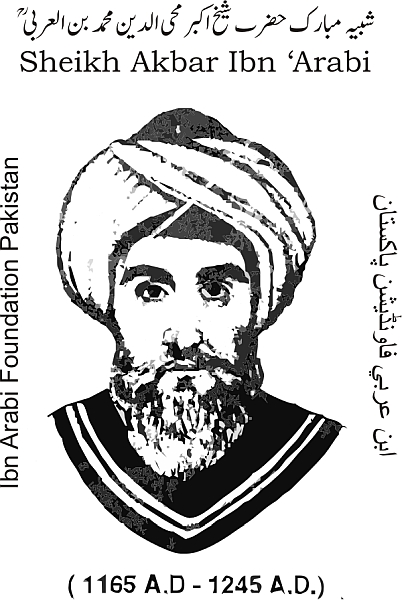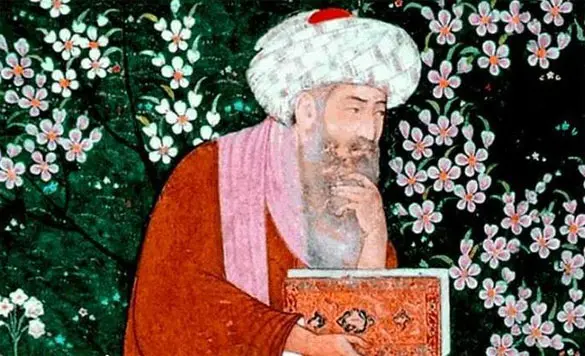
- Ibn-al-Arabi
- born: 1165, Murcia, Spain
- obit: Damascus 1240 Abu Bakr Muhammad
Muhyi al-Din Ibn al-Arabi was born in Murcia into a very pious and cultured milieu. When he was seven, he and his family moved to Seville, the capital of the Almohades Empire which extended all over North Africa. At 16, having studied with Andalusian spiritual leaders, he‘ entered on the path’. He was so cultured that at an early age he was awarded an important administrative post; it was also at this time that he met and married a young woman whom he considered to be the spiritual ideal. But a grave illness which brought with it powerful visions led him to give up his career and his possessions in order to practise asceticism in strict seclusion. Several long years of pilgrimage followed, during which Ibn’Arabi met the greatest mystics in Spain and the Mahgreb, where he spent some time before a vision compelled him to go to the East. In 1201-02 he travelled to Cairo, Jerusalem, and finally to Mecca, where he was welcomed into the home of an eminent Persian sheikh and his sister.
Ibn’Arabi fell in love with the sheikh’s niece, Nizam, to whom he dedicated his masterpiece of spiritual poetry The Interpreter of Longings. From 1204 to 1233 he took up his travels again, coming into contact with all the great Sufi masters of the Middle East. His works brought him fame and he was sought out by princes and accompanied by a group of disciples, but was challenged by the doctors of law who found his doctrine worrying. At last in 1224, Ibn’Arabi settled in Damascus where he remained until his death, setting out to train the minds of the followers and to compile his vast body of work. On his death he was honoured with the title of Vivificator of the Religion, and his body lies at Damascus in the mosque mausoleum built for him by Sultan Selim I in 1517.
Since then Ibn’Arabi’s thought has dominated Sufi spiritualism, but has always been contested, due to the fact that his ideas go beyond the framework of orthodox Islam. By His works we know that Ibn’Arabi was an extremely prolific author, composing more than 300 works, of which only half remains. His works range from poetry to commentaries on the Koran, the most famous of which are the Meccan Revelations, his monumental encyclopaedia in which he studies all aspects of spirituality in 156 chapters; The Book of Theophanies (c. 1204), in which he develops his philosophy of the Being, and The Bezels of Wisdom. The latter was compiled in 1229 and is a spiritual testament in which the messages of the prophets from Adam to Muhammad are exposed. The messages are described as so many reflections of the Divine Revelation, which is absolute light and therefore colourless, but the receiver acts like a prism endowing it with many colours. By common consent this is Ibn’Arabi’s most important, daring work, which has met with resistance from the heart of Islam since it first appeared.
Ibn’Arabi’s doctrine, known as ‘unity of existence’ is centred on the absolute unity of the Being.
‘Existence is a single reality: if we look at it from one angle we consider it to be the existence of created things and if we look at it from another, we consider it to be the actual existence of God. Reality is therefore no more than one thing appearing in many forms’.
It follows that in his profound and essential being, man himself is a divine possibility. The development of this archetype, which is capable of directly receiving God-given light, is therefore the aim of spiritual life. As man is the object of his own knowledge, God is the subject, the ‘transcendant Witness’. If, in order to know God, man must first know himself in his spiritual essence, he can only come to know himself in God and through Him. This audacious statement can only be made in Ibn ‘Arabi’s words in a methodically paradoxical manner. The author prevents the reader’s mind from taking up a definitive stance or viewpoint. Instead he continually pushes it towards what he qualifies as ‘perplexity’ and ‘astonishment’ in the face of something which goes beyond the rational.
His theory was denounced by the majority of orthodox theologians. They also condemned what they considered to be his dangerous pantheism, dangerous in that it came close to abolishing the necessary differences between Creator and creature, Lord and servant. Ibn ‘Arabi’s theories were a decisive step in the development of Islamic spirituality, in particular that of the Sufis who went on to organise themselves into brotherhoods. His works, which are so rich and so dense, technical, esoteric and paradoxical at the same time, are not only valued for their theoretical content but also because they are the expressions of a pious man’s profound mystical voyage of discovery. These books have become standard reference works, not only for his modern-day disciples but also for his adversaries. They are of universal value.
The Bezels of Wisdom
It is from God, so hear!
And to God do you return!
When you hear what I bring, learn!
Then with understanding see
The details in the whole
And also see them as part of the whole.
Then give it to those Who seek it, and stint not.
This is the mercy that Encompasses you; so extend it.
The Bezels of Wisdom were given to Ibn-al-Arabi in a dream:
I saw the Apostle of God in a visitation He had in his hand a book and he said to me, ‘This is the book of the bezels of Wisdom; take it and bring it to
men that they might benefit from it.’ The book portrays the wisdom of love through Abraham, of the unseen through Job, of light through Joseph, of intimacy through Elias and so on. In one of his poems he stated, “Love is the creed I hold: wherever turns His camels, Love is still my creed and faith.”
One image that Ibn-al-Arabi employs is that of the seal ring. In this image, man is seen as the seal that seals and protect the cosmic treasure house of God and on which is stamped the signet of its Owner. Thus Adam, as Man, is the receptive wax that bears the image of the all embracing and supreme Name of God.
Ibn-al-Arabi uses the word Bezels to describe each of the 27 prophets named in The Koran. He uses bezels in the sense of a gem set in a ring, a gem with many faces cut into it. Each face is a revelation into the interior of the ring, the centre. In this respect, each prophet the Koran names is a facet of the divine diamond, revealing a different facet of divinity to humanity. Ibn-al-Arabi taught a oneness of being, and often spoke of a state that paralleled the vedantic sat-chit-ananda (being-awareness-bliss). He taught that all of creation reflected the Creator, and there was only the Creator and the mirror in which He saw Himself.

Ibn Arabi Lecture Series ~ Woolfe Institute
This newly established Annual Lecture series, generously endowed by Hilary Williams Papworth in memory of Bill Papworth, derives its inspiration from the universality of Ibn Arabi’s teaching, which naturally leads the student of his work towards an appreciation of the philosophical common ground underlying the triple tradition of Judaism, Christianity and Islam.
Speakers will be chosen on the grounds that their work and thought animates, inspires or illuminates significant issues of our time.
![]()

